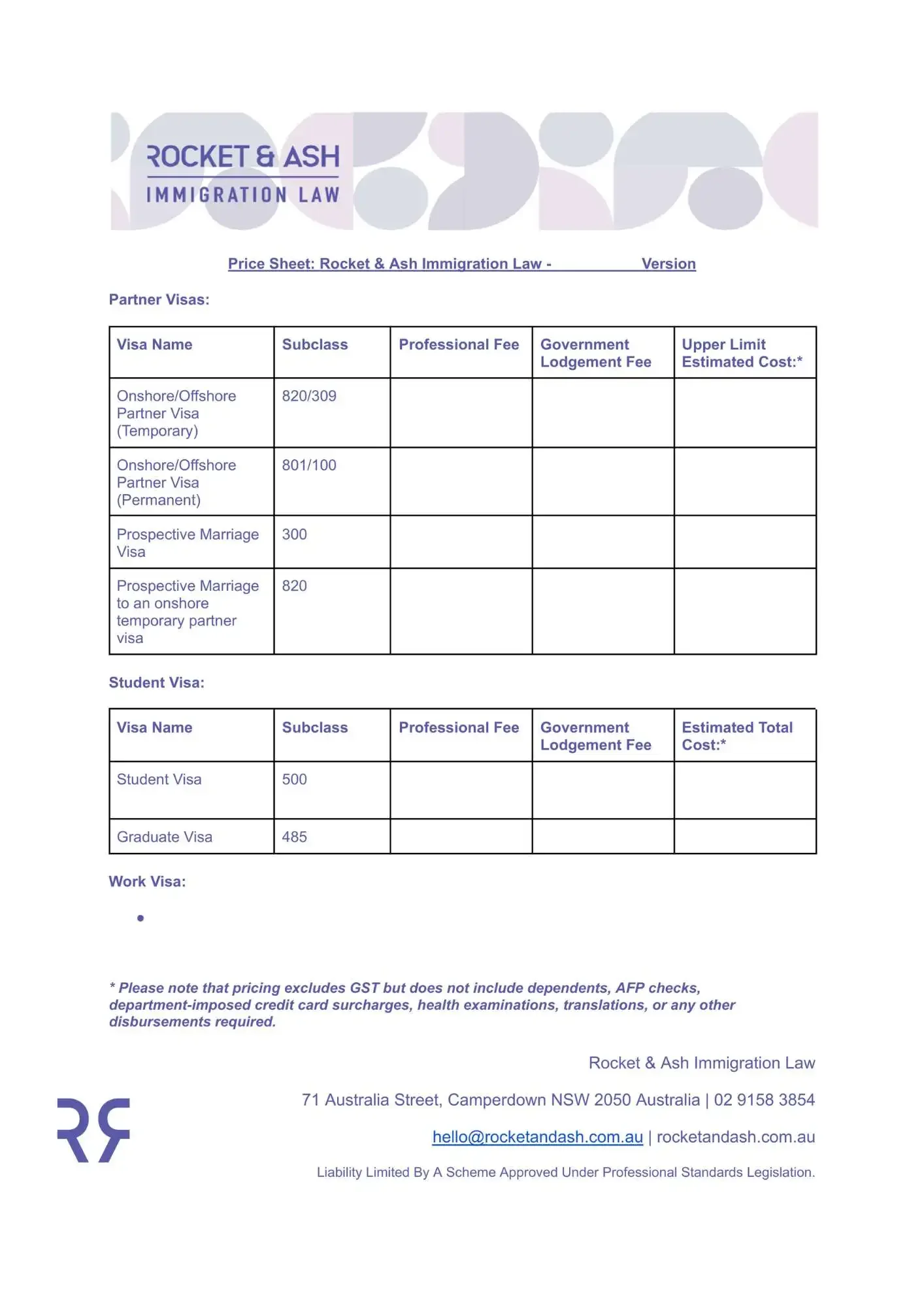Navigating the landscape of Australian partner visas can be challenging. Understanding the intricacies of each visa type is crucial for couples looking to build their lives in Australia.
There are three primary avenues: the onshore partner visa for those already in Australia, the offshore partner visa for those outside the country, and the prospective marriage visa for individuals planning to marry an Australian citizen or permanent resident.
The onshore partner visa, comprising the temporary Subclass 820 and permanent Subclass 801, allows partners of Australian citizens or permanent residents to remain in the country while their visa is processed.
In contrast, the offshore partner visa, which includes Subclass 309 (temporary) and Subclass 100 (permanent), requires applicants to be outside of Australia at the time of application and, most often, when the visa is granted.
The Prospective Marriage Visa (Subclass 300), meanwhile, is specifically for engaged couples. It grants the applicant entry into Australia to marry their partner.
Each type of visa carries its own set of criteria, processing times, and application processes tailored to suit different relationship circumstances.
Key Takeaways
- Partner visas in Australia are designed to cater to different relationship circumstances.
- Onshore and offshore visas differ mainly in the applicant's location at the time of application.
- The prospective marriage visa allows entry into Australia to marry an Australian partner.
Understanding Partner Visas in Australia
As an expert on Australian immigration, I'm here to help you understand the types of partner visas available, the sponsorship requirements, and the application process.
Let's examine the various partner visa categories, understand who can sponsor an applicant, and discuss the application steps.
Definition and Overview of Partner Visa Categories
In Australia, partner visas allow the spouses or de facto partners of Australian citizens, Australian permanent residents, or eligible New Zealand citizens to live in Australia. There are three main partner visa categories:
- Onshore Partner Visas (Subclass 820/801): These are typically for applicants already in Australia. The Subclass 820 visa grants temporary residency and usually leads to the permanent Subclass 801 visa after specific criteria are met.
- Offshore Partner Visas (Subclass 309/100): These are applied for when the applicant is outside Australia. The Subclass 309 is a provisional visa that allows entry, followed by the permanent Subclass 100 visa after fulfilling certain relationship conditions.
- Prospective Marriage Visa (Subclass 300): Known as the fiancée visa, it is for individuals intending to come to Australia to marry their partner. Once married, applicants can transition to an onshore partner visa to reside permanently
Criteria for Sponsorship
To sponsor a partner for a visa, you must meet specific criteria. You should be an Australian citizen, an Australian permanent resident, or an eligible New Zealand citizen. Additionally, you must:
- Be 18 years or older.
- Have met and been in a genuine relationship with the applicant.
- Be in a position to support your partner financially
- Not be related
Sponsorship has stringent requirements to prevent fraudulent applications and ensure support for the incoming partner.
Onshore vs Offshore Partner Visas
Navigating the complexities of the partner visa options in Australia requires a clear understanding of the distinctions and strategic considerations between onshore and offshore applications. This analysis discusses explicitly the key differences, the advantages and drawbacks of each route, and various scenarios that may apply to applicants.
Key Differences in Visa Application
The primary distinction between an onshore partner visa (Subclass 820/801) and an offshore partner visa (Subclass 309/100) lies in the applicant's location at the time of application.
You can apply for the onshore partner visa while residing in Australia. You might be eligible for a bridging visa, which will allow you to remain in Australia while your application is processed. The offshore partner visa requires that you apply from outside Australia and be outside Australia when the visa is granted.
- Subclass 820 is the temporary phase before transitioning to the permanent Subclass 801.
- Subclass 309 is the temporary offshore equivalent, leading to the permanent Subclass 100.
Pros and Cons of Applying Onshore and Offshore
When comparing the pros and cons of applying for a partner visa onshore versus offshore, several factors come into play:
Onshore Application
- Pro: The bridging visa allows you to live, work, and study in Australia during processing.
- Con: You face the uncertainty of being on a temporary visa should the relationship end before transitioning to permanency.
Offshore Application
- Pro: It can be more straightforward for couples living outside of Australia, allowing them to plan their move after visa approval.
- Con: You'll be separated from your partner if they reside in Australia while your application is being processed.
Case Scenarios for Onshore and Offshore Applications
Understanding when to apply for an onshore or offshore partner visa depends on your situation. Here are some scenarios:
- Suppose you're living in Australia with your partner, and you're ready to progress to a stage of permanent residency. In that case, the onshore route is suitable, beginning with the temporary Subclass 820 visa and eventually leading to the Subclass 801 visa.
- Conversely, if your partner is outside Australia but intends to move there, an offshore Subclass 309 visa and progressing to the Subclass 100 visa would be ideal.
Prospective Marriage Visa (Subclass 300)
The Prospective Marriage Visa (Subclass 300) is designed for individuals who wish to come to Australia to marry their prospective spouse. It is a temporary visa that allows entry to Australia before marriage, paving the way for a transition to a permanent partner visa post-wedding.
Eligibility Criteria for Prospective Spouse Visa
To be eligible for the Prospective Marriage Visa, applicants must be engaged to—but not yet married to—an Australian citizen, an Australian permanent resident, or an eligible New Zealand citizen. You must be outside Australia when you apply and when the visa is granted.
Your intention to marry your partner should be genuine, and you should plan to do so within the visa's 9-15-month validity period. Importantly, you must have met in person and know each other personally.
Required Documentation and Intent to Marry
When you apply for this visa, you must provide key documentation, including evidence of your relationship with your prospective spouse, proof of your intent to marry, and statements detailing your relationship history. You must also submit identity documents, police checks, and health examinations.
Documents demonstrating your relationship include photos, communication, and joint financial records.
Transition from Prospective Marriage to Permanent Partner Visa
Once in Australia, and after you marry your fiancé(e), you can apply for an onshore partner visa (Subclasses 820 and 801). You need to do this before your prospective marriage visa expires.
The processing time for transitioning to a permanent partner visa can vary. During this period, you hold a bridging visa to live, study, and work in Australia. The transition is not automatic; it involves submitting a new application with updated proof of a genuine and ongoing partnership.
Supporting Requirements and Obligations
In managing applications for onshore, offshore, and prospective marriage partner visas, I adhere strictly to the guidelines set forth by the Department of Home Affairs. The visa applicant and the sponsor must meet detailed health and character requisites, while the sponsor is also subject to specific obligations and limitations.
Health and Character Requirements
For any partner visa, including those for de facto partners, I ensure that applicants undergo a comprehensive health examination to meet the health requirements set by the Department of Home Affairs.
This examination aims to protect the Australian community's health standards and may affect the applicant's Medicare or other medical benefits eligibility.
In addition to health screenings, character standards must be satisfied. I assess this by checking for any criminal history, and the applicant must provide police clearances from every country they have lived in for 12 months or more over the last ten years.
Maintaining good character is crucial; these character requirements safeguard the Australian community's safety and integrity.
Sponsorship Obligations and Limitations
When you take on the sponsor role, you must demonstrate that you can provide adequate support to your partner without relying on government funding. My obligations include providing financial support and accommodation and ensuring that your partner can access medical benefits if they become eligible.
There are also limitations to my sponsorship. For instance, I may not be eligible to sponsor if I have previously sponsored another partner or was sponsored as a partner myself within the last five years. It's also imperative that I disclose any adverse information to the Department of Home Affairs, as this may affect my eligibility to sponsor.
Frequently Asked Questions
In dealing with partner visas in Australia, I have common queries that shed light on the nuanced differences between onshore, offshore, and prospective marriage visas. Here, I address some fundamental questions to demystify the process and requirements.
How do processing times compare for onshore, offshore, and prospective marriage visas?
Processing times can vary widely and are subject to change. Generally, onshore applications may have a longer processing time due to the bridging visa that allows applicants to stay in Australia.
As of March 2024, the Department of Home Affairs is listing the following processing times for temporary partner visas:
- Onshore Partner Visa (Subclass 820) between 5-31 months for 90% of applications
- Offshore Partner Visa (Subclass 309) between 10-24 months for 90% of applicants
- Prospective Marriage Visa (Subclass 300) between 14-28 months for 90% of applicants
Furthermore, below are the permanent partner visa processing times:
- Onshore Permanent Partner Visa (Subclass 801) between 9-22 months for 90% of applications
- Onshore Permanent Partner Visa (Subclass 100) between 11-22 months for 90% of applications
What are the main benefits of applying for a partner visa in Australia compared to outside?
One of the main benefits of applying for an onshore partner visa is that applicants can stay in Australia with their partner on a bridging visa while their application is processed. This can provide couples with stability and the ability to build their lives together without being separated by border constraints.
What evidence is required to support the relationship for each visa application type?
The evidence required to support the relationship includes, but is not limited to, proof of cohabitation, shared finances, correspondence, and social recognition of the relationship. However, specifics may vary slightly between onshore, offshore, and prospective marriage visa applications.
Are travel restrictions or conditions uniquely applicable to onshore, offshore, or prospective marriage visa holders?
Once granted a bridging visa, offshore applicants generally have travel restrictions and will require a bridging visa B to leave and re-enter Australia. Depending on when the substantive visa expires, this may or may not be necessary, but generally speaking, it will be.
Meanwhile, offshore applicants can face limitations if they want to enter Australia before their visa is decided.
Prospective marriage visa holders can enter Australia to marry their sponsor. However, this visa has a strict nine-month validity period, with no extension available.
About Rocket & Ash Immigration Law
At Rocket & Ash Immigration Law, we specialise in helping partners, graduates, and professionals navigate the complexities of Australian immigration law. Our expertise in visa applications ensures that you receive tailored advice and support throughout your immigration journey.
If you require assistance with your partner visa application or have any other immigration-related queries, our experienced team can help.
Please book a free 15 minute chat with our team if you have further questions.
Written by Ines Jusufspahic, LPN: 5511366
This article does not constitute legal advice or create an attorney-client relationship. For up-to-date information, please consult an immigration professional.
.png)


